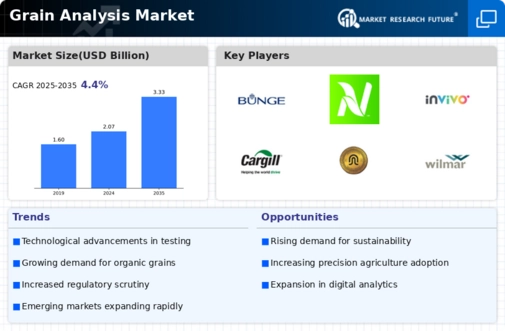Global Trade Dynamics
Global trade dynamics significantly impact the Global Grain Analysis Market Industry. Changes in trade policies, tariffs, and international agreements can affect grain supply chains and market accessibility. For instance, fluctuations in export-import regulations can lead to variations in grain prices and availability. The Global Grain Analysis Market Industry must adapt to these changes to maintain competitiveness and ensure efficient grain distribution. As countries navigate trade relationships, the importance of accurate grain analysis becomes evident in optimizing trade strategies and enhancing market responsiveness.
Rising Global Population
The increasing global population drives demand for food, thereby influencing the Global Grain Analysis Market Industry. As the population is projected to reach approximately 9.7 billion by 2050, the need for efficient grain production and analysis becomes paramount. This growth necessitates advancements in agricultural practices and technologies to ensure food security. The Global Grain Analysis Market Industry is expected to grow to 2.07 USD Billion in 2024, reflecting the urgency to optimize grain yield and quality. Enhanced grain analysis techniques will likely play a crucial role in meeting the nutritional needs of a burgeoning population.
Market Trends and Projections
The Global Grain Analysis Market Industry is characterized by various trends and projections that highlight its growth trajectory. In 2024, the market is valued at 2.07 USD Billion, with expectations to reach 3.33 USD Billion by 2035. The compound annual growth rate of 4.42% from 2025 to 2035 indicates a robust expansion driven by technological advancements, sustainability, and changing consumer preferences. These trends suggest a dynamic market landscape where stakeholders must remain agile and responsive to evolving demands.
Sustainable Agricultural Practices
The increasing emphasis on sustainability in agriculture influences the Global Grain Analysis Market Industry. Farmers and producers are adopting sustainable practices to mitigate environmental impacts, which necessitates comprehensive grain analysis. This shift towards sustainability is driven by consumer demand for eco-friendly products and regulatory pressures. The Global Grain Analysis Market Industry is expected to witness a compound annual growth rate of 4.42% from 2025 to 2035, as stakeholders prioritize sustainable grain production methods. Enhanced grain analysis will be essential in ensuring that these practices are effective and yield high-quality grains.
Consumer Preferences for Quality Grains
Shifting consumer preferences towards high-quality and organic grains are reshaping the Global Grain Analysis Market Industry. As health-conscious consumers increasingly seek nutritious food options, the demand for quality grains rises. This trend compels producers to invest in advanced grain analysis techniques to ensure product quality and safety. The Global Grain Analysis Market Industry is poised for growth, with projections indicating a rise to 2.07 USD Billion in 2024. Meeting consumer expectations for quality grains will likely drive innovation and investment in grain analysis technologies.
Technological Advancements in Agriculture
Technological innovations in agriculture, such as precision farming and data analytics, are pivotal in shaping the Global Grain Analysis Market Industry. These advancements enable farmers to monitor crop health, soil conditions, and weather patterns, leading to improved grain production efficiency. The integration of artificial intelligence and machine learning in grain analysis is anticipated to enhance decision-making processes. As a result, the Global Grain Analysis Market Industry is projected to expand significantly, potentially reaching 3.33 USD Billion by 2035. This growth underscores the importance of leveraging technology to optimize grain quality and yield.
















